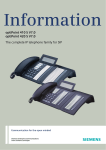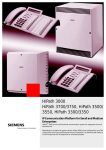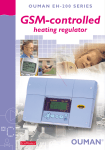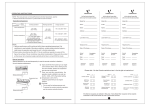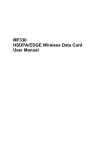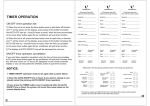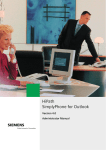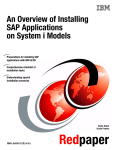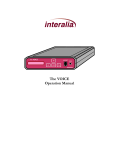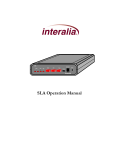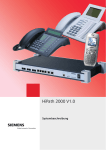Download Siemens L30280-D622-B579
Transcript
Information OpenScape Xpressions Advanced Unified Messaging Your personal communication center Communication for the open minded Siemens Enterprise Communications www.siemens.com/open The smooth flow of information, flexibility, and speed have become decisive success factors for modern, competitive organizations. To be flexible and fast, it is also important for communication within the organization, and especially with customers and suppliers, to function smoothly. tion or on a mobile phone. You can then call up your messages on your PC in the office, at home or in your hotel. The Home Office system also runs smoothly if the teleworker has access to company resources at all times. This is not a problem with OpenScape Xpressions. OpenScape Xpressions is a solution designed to improve internal and external communication. With the supplementary fax-on-demand feature your customers have round-theclock access to information such as current prices, product data, and market and weather forecasts. A service that will allow shrewd organizations to save money or even earn some. OpenScape Xpressions supports users in the day-to-day exchange of voice, fax, and e-mail information. And users can be located virtually anywhere. Thanks to flexible accessing they can reach OpenScape Xpressions via a telephone or PC in the office, from home (as a teleworker, for instance) or while out and about (on business trips, visiting customers, etc.). Groups of people who mainly communicate by mobile phone can be notified through the Short Message Service (SMS) when new messages arrive; they can have SMS messages sent to their mobile phone and access all voice, fax, and e-mail messages. So OpenScape Xpressions provides a flexible solution for all the organization’s user groups. OpenScape Xpressions combines the services ● ● ● ● Voice mail Fax mail E-mail and SMS on a single Windows 2003 or 2008 server to create a unified messaging system. Thanks to its modular, scalable client/server architecture, this solution ensures optimum matching to our customers’ individual communication requirements. Open standards, integration into existing DP and telecoms environments, universal access to messages via a PC and telephone, and protected access with user ID and password via ISDN, LAN, and the Intranet/Internet guarantee safeguarded investment for the future. You can choose services, user packages, various types of DP integration, and software-only solutions, or certified complete systems to suit your requirements. So we can supply the right solution customized to any need, from a small, entry-level version to networked communication solutions. OpenScape Xpressions is mobile and makes people mobile. For example, a separate mailbox can be set up for each of your employees. New messages are not only signaled on the PC; they will, if required, also be signaled on any telephone at a worksta- Benefits and costeffectiveness The communication solution with OpenScape Xpressions permits the shared use of voice, fax, SMS, and e-mail, thereby greatly improving universal, 24-hr accessibility. Chiefly responsible for the extended benefits are: ● Efficient control of field service personnel and increased mobility through interworking of the communication media voice, fax, e-mail, and SMS. ● Improved customer service due to an expanded range of offered information and services. ● Saving hardware components for the different services. ● Reduced costs for administration, maintenance, etc. Services Unified Messaging Unified Messaging means the integration of the services voice, fax, e-mail, and SMS. All personal messages are available for retrieval in a user mailbox. Internet-oriented functionality allows you access on the PC with all IMAP4 clients (such as Netscape Communicator or Outlook XP/2003/2007). So you don’t have to give up your familiar user interface. When out and about, you control your mailbox very easily using the telephone. Unified Messaging is particularly attractive for organizations that have not had an email system before. They save having to make this separate investment without having to go without an efficient e-mail component with Internet capability. The services are also easy to integrate in your existing communications landscape. Optimized versions are available for MS Exchange, Lotus Notes, and SAP R/3 (see DP integration). Fax-mail and fax applications Users each have a personal, cross-service mailbox with their own DID number for sending and receiving fax messages. This mailbox is password-protected against unauthorized access. Receiving faxes Fax messages addressed to a user’s fax number are stored in that user’s mailbox, where they are available for retrieval or processing. Automatic fax tone detection If call forwarding has been activated on the workstation telephone, calls are checked by OpenScape Xpressions for fax service in keeping with the typical functionality of analog telephone/fax combination devices and, where applicable, changed over to receiving a fax message. Deputizing arrangements Each received message can be automatically sent to another user to ensure that no messages go unprocessed (when people are on vacation, for instance). Fax viewer/editor Received fax messages can be shown on the PC using a standard fax viewer/editor for TIFF or JPEG format and further processed. Output to a LAN printer Received fax messages do not have to be printed out on a fax machine; they can be output at any time on a LAN printer. This can significantly reduce the number of fax machines needed in the organization. Output of e-mails as fax Received e-mails, incl. convertible attachments, can be output as a fax on any fax machine. This means you’ll always be kept informed, even while you’re out and about. Archiving Incoming fax messages containing, for example, important organizational data are not only sent to the original recipient; a copy of these messages can also be filed in a separate mailbox (for central archiving with an external application, for instance). Sending faxes ● Fax cover sheet and logo A fax cover sheet and logo can be used on an individual user basis when faxes are sent. ● Fragmented fax transmission If transmission is interrupted it will be resumed on the interrupted page. Resumption of transmission can be indicated by a configurable notice. ● Sending from an MS Office application Fax messages can be generated and sent directly from an MS Office application (such as MS Word for Windows, MS PowerPoint, etc.). ● Scheduled transmission Users can specify the period for sending faxes using the priority levels standard, medium, and high. The same periods are assigned to the priorities centrally for all users. Fax-on-demand Fax documents stored in OpenScape Xpressions are ready for retrieval as required. These documents each have a permanently assigned number. A document is transmitted by dialing this number from a fax machine. The connection costs with this type of transmission are borne by the caller. Voice-mail The OpenScape Xpressions voice-mail application offers every user the possibility of receiving, storing, and forwarding voice messages, and replying to them and adding a comment. This interface is available from a telephone or PC. Fax and e-mail messages can also be output via voice-mail. Faxes can be forwarded to a printer, for instance, or sent to any fax machine.And it is possible to have e-mails read out (text-to-speech). User prompting Acoustic prompts support you in the handling of all functions. You can call up detailed additional information via the Help function. When using a digital terminal connected to Hicom 300 E/300/300 H or HiPath 4000 you will be informed about the individual steps via the display in addition to the spoken user prompts. For the functions named, on a project-specific basis you can choose between German, UK or US English, French, Canadian French, Italian, Portuguese, Brazilian Portuguese, Latin American Spanish, Turkish, Russian or Dutch user prompting for each user. In these languages, the user prompting system is comparable to the Hicom PhoneMail or Hicom 300 VMS interface.. Users can configure their interfaces via the administration level if this is available in the system. For external and internal callers When you are absent (in a meeting, on a business trip or on vacation, etc.), you have the option of redirecting calls to your mailbox. Callers will hear your personal announcement and, after a signal tone, can leave a message. This also applies if the user’s mailbox limits have been reached. Callers who do not want to leave a message but wish to talk to someone directly can set up a phone connection to a deputy or to the exchange without having to call again. Different announcements can be recorded for different redirection situations. The temporary announcement of the day is valid until midnight of the same day. For mailbox owners Entry of the OpenScape Xpressions access number is followed by a prompting announcement. Users have to enter their personal number and a password to listen to new messages (voice, fax, e-mail), send messages, etc. Password All messages saved are password-protected. This password can be modified by the user at any time. If an incorrect password is entered repeatedly, OpenScape Xpressions will break off the connection and, for outside callers, set up a connection to the exchange. Receiving messages You determine whether, in your absence, callers only hear an advisory text (advisory function) or can leave a message after the announcement (answering machine function). In the case of new messages, the system can be configured to make these available to you at a URL address. Visual and acoustic signaling On digital terminals with a display, new messages are signaled visually by lighting of the mailbox lamp and, on lifting the handset, by an announcement. After the user has pressed the mailbox key, the display of the digital telephone connected to Hicom 300 E/300 or HiPath 4000 indicates the arrival of a message in OpenScape Xpressions. With analog and digital telephones without a display, you only have an acoustic indication. Messages can be retrieved via the standard access to the user’s own mailbox. User outcall You can arrange to be notified through SMS when new messages arrive. This can be freely configured by each user on an individual service basis. So depending on your requirements, you will receive a short message on your mobile phone for voice-mail, fax-mail, and e-mail. These settings can be changed at any time from the telephone, or conveniently using the Web Administration Client. Listening to messages By dialing your mailbox you can listen to stored messages on the telephone wherever you are and whenever you want. You can also go forward or back within a message or pause. Replying to/forwarding messages After listening to a message you can delete it, save it or process it. For example, you can speak the reply to an internal party’s inquiry in that person’s mailbox without having to dial the number again, or set up a direct connection to the internal or external sender.The message can also be forwarded to other mailbox owners with a comment appended. Messages with comments can also be passed on with additional comments appended. Personal announcements/Central announcements This functionality is available to you on the telephone and PC. ● ● voice-mail fax-mail e-mail and the following “message queues”: ● messages which could not be sent due to a broken phone connection (e.g. when using a mobile phone) ● received messages or messages which could not be delivered, ● new messages, ● messages already listened to, ● messages that will be sent when the connection to OpenScape Xpressions has been concluded. If there are several messages you can skip forward and backward to find a specific message. In your OpenScape Xpressions mailbox on your PC you can select your voice message and also feed it out via, for example, the integrated loudspeaker. Personal announcement (greeting) Mailbox owners can each speak their personal name announcement. If they do not, the dialed party’s number will be output as the default. You can also: ● use the temporary announcement of the day, which is valid until midnight of the same day ● choose between nine personal announcement texts. Users can assign these announcement texts to the following call situations, depending on the time of day: – alternative announcement (used for internal and external callers), – announcement for internal callers, – announcement for external callers – announcement when busy If you have not activated a personal announcement, the system announcement is used as the default and callers can then leave a message. ● Use the predefined assignment of announcements to particular situations. ● Central announcement Alongside the personal greeting announcements it is also possible to set up central announcements valid for all users. Sending messages ● To a single recipient You can forward a spoken message to another user’s mailbox. This can be done at any location round-the-clock. ● To distribution lists You can set up personal distribution lists on your PC and then send messages to specific groups of recipients. Each distribution list can contain up to 99 directory numbers. Central distribution lists can also be set up for all mailbox owners. OpenScape Xpressions can distinguish both the different services such as ● ● Creating messages A voice message can be accepted and sent not only on the telephone but also on the PC. Group mailbox Several people can use a common mailbox. This enhances group availability and simplifies the answering of queries. Automated Attendant The Automated Attendant function is provided to improve availability for customers. After listening to the greeting and list of options available, a caller can either select another contact, set up a direct telephone connection to the selected contact or connect the call to the operator. In-house/Internet e-mail Companies can use the e-mail functionality of OpenScape Xpressions independently of other e-mail systems (e. g. MS Exchange or Lotus Notes) for in-house and Internet mail. The e-mail system is based on the SMTP standard (Simple Mail Transfer Protocol). Emails can be sent and received using IMAP4 clients (suchas Netscape Communicator, Outlook XP/2003/2007, and Outlook Express) or the proprietary OpenScape Xpressions Communication client specializing in fax functionality. Automatic, userspecific import of Internet mails stored on a POP3 server of your Internet provider is also offered. You can control the timetable centrally and so minimize your connection costs. Provider costs can be optimized if you activate deferred sending of all e-mails. High-priority e-mails will still be sent immediately. Audio conferencing Outlook and Notes support invitations to voice conferences. Implementation can be actively supported via the web client. If documents must be exchanged (application sharing), this can take place in parallel via web conferencing. These types of conference can also be supplemented on both sides by instant messaging/chat. Available with connections to HiPath 3000, HiPath 4000 or HiPath 8000/OpenScape Voice. Short Message Service (SMS) Via an SMS box that can be connected to OpenScape Xpressions, or via direct dialing with a service provider, the cost-effective, direct transmission of SMS messages to GSM 900/1800 networks (e.g. D1 and D2 mobile telephones) is possible (GSM 1800 only via SMS box). With OpenScape Xpressions, standard clients such as MS Exchange, Outlook or Internet browsers allow SMS messages containing up to 160 characters (including special characters) to be sent easily and conveniently. The directory numbers left in the message can be selected on the mobile and immediately dialed. If the mobile has been switched off, the message will be stored by the carrier for up to 48 hours. No additional charges are incurred by the recipient. The Short Message Service is also used for signaling new messages. This can be set on an individual user and service-specific basis on a web site or by telephone (see Web Assistant). OpenScape Xpressions optiClient Extension The following functions are available for PCoriented users: ● make calls, ● receive calls, and utilize more complex functions – such as phone conferences – all from your preferred workplace. optiClient Extensions support: ● simple maintenance of private contacts in the contacts list ● making a call via the teambar ● link to an external adress book, using LDAP, for example ● integration of optiClient function in Outlook or Lotus Notes clients optiClient is used as a client on the Xpressions Server. This means that additional functions can be made available via Xpressions. These include: ● documenting successful/unsuccessful calls independently of optiClient ● the Xpressions-based Presence function, providing information about the availability of other users Short message/SMS dispatch A button is available for convenient SMS dispatch. A transmit window is presented in which you only need to enter the required text. The program takes care of the address syntax. If a mobile radio number has been entered in the Outlook directories, this will be pre-assigned automatically in the send window. Voice/fax forms Voice and fax messages are identified by their own symbols for improved clarity. The new forms become active when the messages are opened. The viewers are integrated; in the case of faxes, for instance, you are given a direct overview (over several pages, if necessary), and can selectively display a page and process the message.When forwarding or answering you can use a toolbox with the most important components for commenting. Voice messages can be conveniently listened to thanks to integrated players and recorders, and suitable comments can be appended prior to answering. DP integration OpenScape Xpressions can also be linked into your organization’s existing infrastructure and will meet all requirements placed on an innovative communication solution. Efficient integration in ● ● ● MS Exchange Lotus Notes, and SAP R/3 is available. Other e-mail systems can be connected on the basis of an SMTP integration. Integrated Messaging with MS Exchange/Lotus Notes With this package, MS Exchange/Lotus Notes users can receive and send all their messages (voice, fax, e-mail, SMS) in their familiar e-mail environment. Mobile users also have the option of accessing all messages while out and about and, for example, of having e-mails read out using textto-speech. The message statuses are fully synchronized. This means that if a message is deleted on the desktop it will no longer be available for telephone retrieval. Or if a message is listened to on the telephone it will be identified on the desktop as having been read and the mailbox lamp on the workstation telephone will be extinguished. The user data can be automatically replicated from MS Exchange/Lotus Notes to OpenScape Xpressions. This ensures uniform administration under MS Exchange/Lotus Notes. OpenScape Xpressions is linked to MS Exchange via a connector by default. Linking into Lotus Notes is on the Lotus Notes client principle, meeting the high-level security standards of Lotus Notes. True Unified Messaging with MS Exchange/Lotus Notes True Unified Messaging or Single Message Store enables a reduction in the redundant data storage (inbox replication) of integrated messaging. In the case of integrated messaging, emails are copied from the e-mail data server to the Xpressions system, making them available for telephone queries or the Xpressions Web Assistant. Cross-service features Conversely, voice-mails and fax messages are transferred from Xpressions to the email server so that they can be accessed via a standard e-mail client such as Outlook, for example. This replication does not apply when using the Single Message Store feature and thereby the required “doubled” memory location on the Xpressions server for all replicated data. The TRUE UM Connector enables telephone queries to access MS Exchange 2003, 2007 and Lotus Domino R6, R7 and Lotus R8 inbox. SAP R/3 link OpenScape Xpressions employs the standardized SAP connect interface and has been certified by the company SAP AG. Within your familiar SAP R/3 user interface you also have the option of sending faxes and SMSs and receiving faxes and voicemails. Field service employees can also be notified of new messages while out and about and, for example, have received emails read out (text-to-speech). Message handling takes place separately in both systems within the framework of the possibilities offered by SAP connect. This means there is no full synchronization. Broadcasting A message can be passed on to a pre-defined number of recipients in what-ever services are preferred. Accessing your messages – anywhere and any time You can access your own password-protected mailbox, and hence all received messages (voice-mail, fax-mail, e-mail) at any time, regardless of location and platform, using a telephone, Intranet/Internet or via the OpenScape Xpressions Web Assistant. Message Waiting Indication New messages can be signaled both on the PC (e.g. via a pop-up window or URL), by means of a mailbox lamp on a digital Hicom telephone, and via SMS on a mobile phone. Users can each freely configure the notification on a service-specific basis, matching it to their personal communication needs. Speed dialing address book (central/personal) All services are based on unique addressing. Each destination address can be individually assigned a speed dialing number to make it easier to enter addresses. Address entries can be administered centrally in OpenScape Xpressions, and so are available to all users. Each user is also able to maintain a personal address book in their PC client. Number redial If an attempt to set up a connection fails, number redial is activated automatically. In the fax-mail service the period between individual dialing attempts and the number of dialing attempts can be set by the administrator. Postmaster mailbox Any incoming message that is incorrectly addressed is automatically forwarded to a postmaster mailbox (over-flow). This ensures that no messages are lost in OpenScape Xpressions. Call detail recording Message status All necessary information (in particular the party’s number) is transferred to the Hicom/ HiPath system, from where it is included in Hicom’s call detail recording data. All send and receive procedures of all users set up in OpenScape Xpressions are also stored in the OpenScape Xpressions system journal. Errors during on-going operation can be reported to the HiPath 4000 HDMS. User data can be configured via HiPath User Management. Messages can now also be marked confidential, urgent and with the annotation to be dispatched at a later date. A confidential message cannot be forwarded via telephone by the recipient. This is, however, possible via an e-mail client. In the inbox menu, urgent messages are placed at the beginning of the second message group after declined messages and confirmations of receipt or can be moved via the Rules Wizard into the specific “Xpressions” folder. Acknowledgement from the recipient can also be requested through indication of whether the message has been received, read or deleted. Low-cost telephoning via a mobile phone Announcements (personal/ company announcements) Mobile phone users can dial their mailbox and arrange to be connected to another partner. They can use more favorable telephone charge rates, for example in corporate networks. Time-dependent announcements can be set up by the mailbox owner on the PC. Internal announcements, external announcements, announcements when busy, announcements outside business hours or an alternative greeting are differentiated. Personal announcements have the following dependency: alternative greetings take priority independent of the time of day. If busy, the busy announcement is always played, also independent of the time of day. The time of day activation applies for all other types of announcement. The skipping of announcements can only be prevented from the PC. A temporary announcement of the day takes priority, alternative announcements are used from midnight onwards. Fault/usermanagement MyXpressions Folder Each user can create a separate inbox folder called “MyXpressions” in the e-mail system. Specific messages which fulfil the defined conditions can be accumulated and copied via The Rules Wizard. This advantage becomes apparent particularly when dialing from the telephone, because this folder is now available as the first inbox and not all messages are arranged sequentially. This enables the filtering of important messages and ensures shorter response times. New and read messages are differentiated in this folder. Name dialing In addition to dialing a user via their number, the user can alternatively be identified by their name in the case of guest and direct access. Entry is performed via the letters on the telephone keypad. Once Xpressions has detected either a minimum number of entered digits or that entry has been completed, matching names are searched for in the existing data. Up to 6 options can be offered, the following can be activated via an additional key. Users are then displayed in ascending order of telephone numbers. Notification function In addition to setting the mailbox LED for one or more parties, Xpressions can control the following media when a new message is received: telephone (user outcall), pager, or SMS for GSM-based mobiles (only GSM900 and GSM1800 networks). Mobile reachability Administrators can set up a mobile reachability option within a region. A special command is defined for this. Mailbox owners then define a station number, at which they can be reached, under the answering machine options in their mailbox. This option must be offered to callers with the personal announcement. In addition, call forwarding can be activated externally. OpenScape Xpressions Web Assistant The Web Assistant grants web access to the user’s mailbox to modify user settings or check the inbox. The following menus with extensive functionalities are among those available for you to choose from: ● ● ● ● ● ● Mail client with inbox CTI journal (if configured) Sent items Create new message Enquiry/search function Personal settings OpenScape web client The web client is a server-based CTI solution for the Intranet. Software installation and configuration is performed centrally on the server. User-specific journal data and settings are also saved on the server. This eliminates the need for workstation installation that is normally required for clients. This ensures fast and convenient distribution via the Intranet. Even if the user’s computer is switched off, all journal data relevant for that user remains stored on the server and is immediately available when the user logs in again. The user data is backed up on the server. A web browser is sufficient in order to call up the web client. This allows the web client to be used immediately on every computer on the Intranet. Administration Web Assistant System administration The following menus with extensive functionalities are available for you to choose from: System journal All send and receive operations of all users set up in OpenScape Xpressions are stored in this database. For data protection reasons, this journal can only be read by authorized persons. We can offer you the implementation of a report generator for individual evaluations on a project-specific basis. You can specify the selection criteria yourself (evaluation period, database fields, etc.). Primarily resource- or user-related reports can be generated through access to OpenScape Xpressions database tables. Possible subjects of these evaluations include call charge evaluation, individual call verification, server capacity utilization, and service monitoring. 10 predefined reports are currently available with OpenScape Xpressions, and can be used in combination with Crystal Report. ● ● ● ● ● ● ● ● ● ● Personal user data Voice mail system Menu for configuring forwarding Notification Distribution Fax forms Time profiles Recordings Default output devices Mail tracking The Web Assistant supports you in a variety of ways. Whether, for instance, you want to change your user language, select a fax cover sheet, set deputies, use an audio file as an announcement, set up mixed distribution lists or set Message Waiting signaling on a service-specific basis. Simple switching functions, such as the creation of time-controlled call forwarding destinations (various announcements during or outside of business hours), by DTMF selection during an announcement are just as easily realized. Operation of the Web Assistant is self-explanatory. If there are any unanswered questions you can also use the extensive online help. Line monitor This serves to display messages relating to status, performance, diagnosis, etc. for the entire OpenScape Xpressions system. It is also possible to configure individual OpenScape Xpressions modules. Remote administration OpenScape Xpressions can be remotely administered via the ISDN, LAN, Intranet/Internet. Various tools such as Remote Access Service (RAS) from MS Windows 2003, HISPA/SIRA or PC Anywhere can be employed to do this. Networking Several OpenScape Xpressions can be networked via ISDN and LAN. TCP/IP is used as the transport protocol. As an essential requirement for this, OpenScape Xpressions must be incorporated via Domain Name Service (DNS) in the LAN. Voice-mail networking via VPIM, AMIS or PhoneMail LDN via Connect Server are possible, analog (e.g. to Siemens VMS or PhoneMail) is also possible on a project-specific basis. LDAP Connector LDAP interface support for data exchange with X.500 systems (e.g. MetaDirectory). PBX integration OpenScape Xpressions can be connected to the following PBXs: ● HiPath 4000 ● HiPath 3000 ● HiPath 8000/OpenScape Voice ● Realitis DX ● Other, non-Siemens PBXs (on a projectspecific basis) Configuration is scalable from 2 channels (S0) to 300 channels (S2M) in keeping with the requirements. For large configurations it is possible to set up distributed or networked systems. The CorNet N/NQ protocol was implemented to ensure optimum incorporation in Hicom systems. For example you save channels to OpenScape Xpressions because when connecting to other users from voice-mail the call processing function is transferred directly to Hicom. And your voice-mail user prompting is improved through additional display texts on your digital workstation telephone. Alternatively, you can utilize the IP connection to HiPath 4000 or the SIP connection to HiPath 8000/OpenScape Voice. HiPath 4000 ab V3.0 Corporate LAN IP CorNet IP HiPath 4000 Ethernet DIU ST 2 MD S2M / S0 CorNet N / NQ OpenScape Xpressions V6.0 Unified Messaging Server HiPath 8000 V.24 SIP CorNet N GSMNetwork D1 D2 SMS-Box HiPath 3000/5000 Configuration overview Telephone Systems Hicom 300/300 E /300 H HiPath 4000 ISDN, GSM, Internet E-Mail Voice Fax SMS DIU ST 2 MD HG 50 HiPath 4000 V3.0 or higher STMD S0 /S2M CorNet N Subset SIP OpenScape Xpressions V6.0 Unified Messaging Server S2M / S0 CorNetN/NQ 35 HiPath 8000 Hicom 150 E / 150 H HiPath 3000/5000 IP D2 D1 LAN GSMNetwork SMS-Box TCP / IP CTI E-Mail Voice Fax SMS Client Lotus Notes 6.0, 6.5, 7, 8 MS Outlook XP, 2003, 2007 Unified messaging with Exchange and Lotus Notes MS Exchange 2003, 2007 E-Mail-Server Lotus Notes 6.0, 6.5, 7, 8 E-Mail-Server Technical Data OpenScape Xpressions V6 Connection Connection to ● ● ● ● ● ● ● ● ● ● ● ● HiPath 3000 from V5.0 with CorNet N HiPath 4000 from V2.0 with CorNet NQ HiPath 4000 from V3.0 with CorNet-IP HiPath 8000/OpenScape Voice from V2.2 with SIP HiPath DX with CorNet NQ Hicom 150 E/H with functionality of Xpressions V4.0 Hicom 300 E/H with functionality of Xpressions V4.0 HiPath 3000 before V5 with functionality of Xpressions V4.0 HiPath 4000 V1 with functionality of Xpressions V4.0 HiPath 8000 before 2.2 with functionality of Xpressions V4.0 Project specific, other PBX (DSS1/QSIG) Customer LAN (TCP/IP) (100 BaseT) Project specific released are these connectivities: Cisco CallManager 5 and 6 (SIP) ● Alcatel OmniPCX Enterprise (ISDN) ● Nortel CSE 1000 (ISDN) ● Avaya S8300 (SIP) ● Number of channels per server/distributed system at Hicom 300 / HiPath 4000 Up to 60 / 300 channel / ports, of which Max. 60 / 300 Voice ● Max. 60 / 300 Fax ● Number of channels per server to Hicom 150 E / HiPath 3000 Up to 60 channels / ports, of which ● Max. 60 voice ● Max. 60 fax Number of channels per server using IP-connectivity (G.711) HiPath 4000: max. 30 channels per PC / max. 300 per distributed system HiPath 8000/OpenScape Voice: max. 60 channels per PC / max. 300 per distributed system For G.729 max. 40 channels per PC / max. 280 per distributed system Number of channels for audio conferencing 150-200 channels when using 8 core computers Access to user mailbox Telephone access to ● ● ● PC client access to ● ● ● Voice mail Fax mail E-mail Voice mail Fax mail E-mail Supported services Supported desktop clients supported ● Netscape Communicator 7.1 Internet Explorer 6.5 und 7.0 Microsoft Outlook XP/2003/2007 Microsoft Outlook Express V5.5/V6.0 OpenScape Xpressions Communications Client OpenScape Xpressions Web Assistant E-mail integration with Microsoft Exchange ● MS Exchange 2003 or Exchange 2007 E-mail integration with Lotus Notes / Domino ● Lotus Notes/Domino R6.0 / 6.5.1 / 6.5.3 / 6.5.4 Lotus Notes/Domino R7.0 / 7.01 / 7.02 Lotus Notes R8.0 ● ● ● ● ● ● ● E-mail gateways ● ● SAP R/3 from 4.5b via SAPconnect SMTP mail OpenScape Xpressions V6 Directory integration via LDAP Connector Customer Directory SMS (Short Message Service) SMS message to mobile telephone on arrival of new message or via mail client GSM 900/1800 networks Max. number of characters to be transmitted (including special characters) Max. 160 characters Number of messages per SMS box Approx. 300 per hour Number of SMS boxes per OpenScape Xpressions V5 Max. 2 Fax services Fax services Fax G3 Fax coding in accordance with T.30 Yes Fax coding in accordance with T.38 Yes Fax On Demand Yes Access protection Mandatory password Yes Min. number of characters in the personal password 1 Max. number of characters in the personal password 24 Configuration sizes Max. number of users / mailboxes E-mail in case of replication Voice mail Unified Messaging (voice mail, fax mail, SMS) Primergy / Distributed System 600 4,000/20,000 2,000 /10,000 Max. number of messages per user Dependent on HDD, not strictly limited Max. message memory per mailbox Dependent on HDD, not strictly limited User languages on telephone and display V6: German, English (UK), English (US), French, French (Canada), Italian, Spanish, American Spanish From V6 R1: also Dutch, Portuguese, Portuguese (Brazil) Turkish, Russian, Japanese No display Max. number of individual distribution lists per user 99 Max. number of addresses per distribution list 99 Max. number of announcements per user 9 Hardware requirements PC server min. equipment Processor (Intel only) Minimum: Intel Pentium III 1 GHz (Upgrades) Standard: Intel Pentium IV 2 GHz High End: Intel Pentium IV > 2 GHz RAM Minimum/Standard: 2,048 MB + 128 MB for >2P + 128 MB for Exchange + 2 MB per TTS channel + 100 MB per installed voice + 2,048 MB for audio conferencing + 1,048 MB for OpenScape web client High End: > 2,048 MB Hard disk (for 4 GB or more with 1 GB FAT, rest NTFS) Additional hard disk for data backup Minimum: 4 GB (in the event of upgrading) Standard: 2 x 100 GB (IDE or SCSI) High End: n x 9/18/36/72 GB (RAID5) DVD drive For installation LAN card Ethernet (10BT/)100BT OpenScape Xpressions V6 V.24 / COM port Additional V.24 board possibly necessary from 2nd COM (service modem, if necessary MWI modem) PCI slots (for voice/fax interface boards) (Standard from V2.0) Minimum: 2 Standard: 3 Maximum: 5 Operating system (32-bit) ● ● ● ● Windows 2003 Server R2 Windows XP Professional SP2 Windows 2003 Enterprise Server R2 SP2 Windows 2008 Enterprise Server Hardware requirements – PC client Processor Minimum: Windows 2000: Pentium IV, 1,300 MHz ● Windows XP: Pentium IV, 1,300 MHz ● Windows Vista: Pentium ● Recommended: >= 3.0 GHz RAM Minimum: 512 MB Recommended: >= 1,024 MB LAN card Ethernet 10BT/100BT Operating system (recommended) ● ● Outlook (recommended) ● ● ● Optional accessories ● ● ● Windows XP Professional from SP2 Windows Vista Business or Enterprise Outlook XP SP2 Outlook 2003 Outlook 2007 Sound card Microphone Headphones Copyright © Siemens Enterprise Communications GmbH & Co. KG Siemens Enterprise Communications GmbH & Co. KG is a Trademark Licensee of Siemens AG Hofmannstr. 51, D-80200 München; 03/2009 Reference No.: A31002-S2360-D100-1-7629 Communication for the open minded Siemens Enterprise Communications www.siemens.com/open The information provided in this document contains merely general descriptions or characteristics of performance which in case of actual use do not always apply as described or which may change as a result of further development of the products. An obligation to provide the respective characteristics shall only exist if expressly agreed in the terms of contract. Subject to availability. Right of modification reserved. OpenScape, OpenStage and HiPath are registrated trademarks of Siemens Enterprise Communications GmbH & Co. KG. All other brand, product and service names are trademarks or registrated trademarks of their respective owners. Printed in Germany













